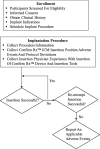Changes in R-wave amplitude at implantation are associated with gender and orientation of insertable cardiac monitor: observations from the confirm Rx™ body posture and physical activity study
- PMID: 36209063
- PMCID: PMC9548115
- DOI: 10.1186/s12872-022-02752-0
Changes in R-wave amplitude at implantation are associated with gender and orientation of insertable cardiac monitor: observations from the confirm Rx™ body posture and physical activity study
Abstract
Background: Insertable cardiac monitors (ICMs) are small subcutaneously implanted devices that detect changes in R-wave amplitudes (RWAs), effective in arrhythmia-monitoring. Although ICMs have proven to be immensely successful, electrical artefacts are frequent and can lead to misdiagnosis. Thus, there is a growing need to sustain and increase efficacy in detection rates by gaining insight into various patient-specific factors such as body postures and activities.
Methods: RWAs were measured in 15 separate postures, including supine, lying on the right-side (RS) or left-side (LS) and sitting, and two separate ICM orientations, immediately after implantation of Confirm Rx™ ICM in 99 patients.
Results: The patients (53 females and 46 males, mean ages 66.62 ± 14.7 and 66.40 ± 12.25 years, respectively) had attenuated RWAs in RS, LS and sitting by ~ 26.4%, ~ 27.8% and ~ 21.2% respectively, compared to supine. Gender-based analysis indicated RWAs in RS (0.32 mV (0.09-1.03 mV), p < 0.0001) and LS (0.37 mV (0.11-1.03 mV), p = 0.004) to be significantly attenuated compared to supine (0.52 mV (0.20-1.03 mV) for female participants. Similar attenuation was not evident for male participants. Further, parasternally oriented ICMs (n = 44), attenuated RWAs in RS (0.37 mV(0.09-1.03 mV), p = 0.05) and LS (0.34 mV (0.11-1.03 mV), p = 0.02) compared to supine (0.48 mV (0.09-1.03 mV). Similar differences were not observed in participants with ICMs in the 45°-relative-to-sternum (n = 46) orientation. When assessing the combined effect of gender and ICM orientation, female participants demonstrated plausible attenuation in RWAs for RS and LS postures compared to supine, an effect not observed in male participants.
Conclusion: This is the first known study depicting the effects on RWA due to body postures and activities immediately post-implantation with an overt impact by gender and orientation of ICM. Future work assessing the cause of gender-based differences in RWAs may be critical.
Trial registration: Clinical Trials, NCT03803969. Registered 15 January 2019 - Retrospectively registered, https://clinicaltrials.gov/NCT03803969.
Keywords: Arrhythmia; Gender; Insertable cardiac monitor; Posture; R-wave amplitudes; Syncope.
© 2022. The Author(s).
Conflict of interest statement
SD, LM and KR are employees of Abbott. All other authors declare No Conflict of Interests for this article.
Figures




Similar articles
-
R-wave amplitude changes with posture and physical activity over time in an insertable cardiac monitor.Cardiovasc Digit Health J. 2021 Dec 30;3(2):80-88. doi: 10.1016/j.cvdhj.2021.12.002. eCollection 2022 Apr. Cardiovasc Digit Health J. 2021. PMID: 35493270 Free PMC article.
-
Diagnostic Accuracy and Safety of Confirm Rx™ Insertable Cardiac Monitor in Pediatric Patients.Pediatr Cardiol. 2021 Jan;42(1):142-147. doi: 10.1007/s00246-020-02463-3. Epub 2020 Oct 9. Pediatr Cardiol. 2021. PMID: 33033869
-
Factors affecting electrogram sensing in an insertable cardiac monitor: Insights from surface electrocardiogram mapping analysis.Heart Rhythm. 2023 Sep;20(9):1297-1306. doi: 10.1016/j.hrthm.2023.05.034. Epub 2023 Jun 13. Heart Rhythm. 2023. PMID: 37321384
-
Implantation of a novel insertable cardiac monitor: preliminary multicenter experience in Europe.J Interv Card Electrophysiol. 2024 Dec;67(9):2117-2125. doi: 10.1007/s10840-024-01821-y. Epub 2024 May 16. J Interv Card Electrophysiol. 2024. PMID: 38755520 Free PMC article. Review.
-
Insertable cardiac monitors: current indications and devices.Expert Rev Med Devices. 2019 Jan;16(1):45-55. doi: 10.1080/17434440.2018.1557046. Epub 2018 Dec 11. Expert Rev Med Devices. 2019. PMID: 30522350 Review.
Cited by
-
"Real-world" performance of the Confirm Rx™ SharpSense AF detection algorithm: UK Confirm Rx study.J Arrhythm. 2024 Sep 3;40(5):1093-1101. doi: 10.1002/joa3.13124. eCollection 2024 Oct. J Arrhythm. 2024. PMID: 39416234 Free PMC article.
-
Comparison of Electrocardiogram Characteristics of Two Commercially Available Implantable Loop Monitors: Impact of These Characteristics in the Correct Adjudication of Recorded Events and Minimized Undersensing and Oversensing of Events.J Innov Card Rhythm Manag. 2025 Jan 15;16(1):6167-6172. doi: 10.19102/icrm.2025.16013. eCollection 2025 Jan. J Innov Card Rhythm Manag. 2025. PMID: 39897723 Free PMC article.
References
Publication types
MeSH terms
Associated data
LinkOut - more resources
Full Text Sources
Medical

